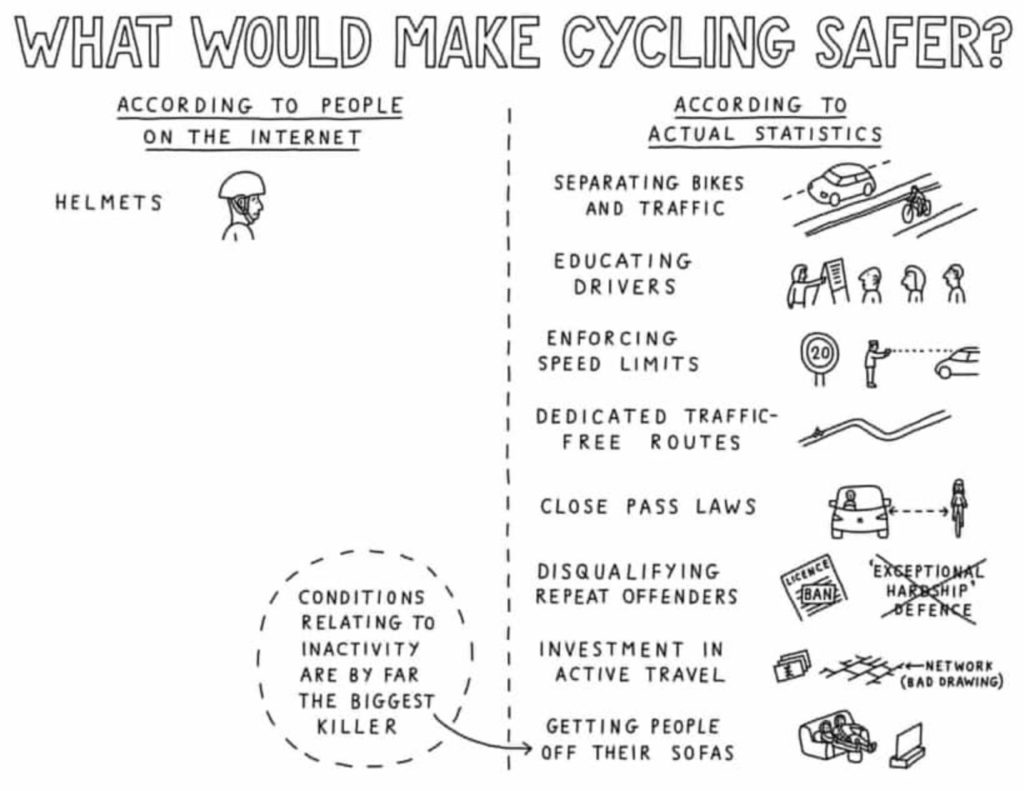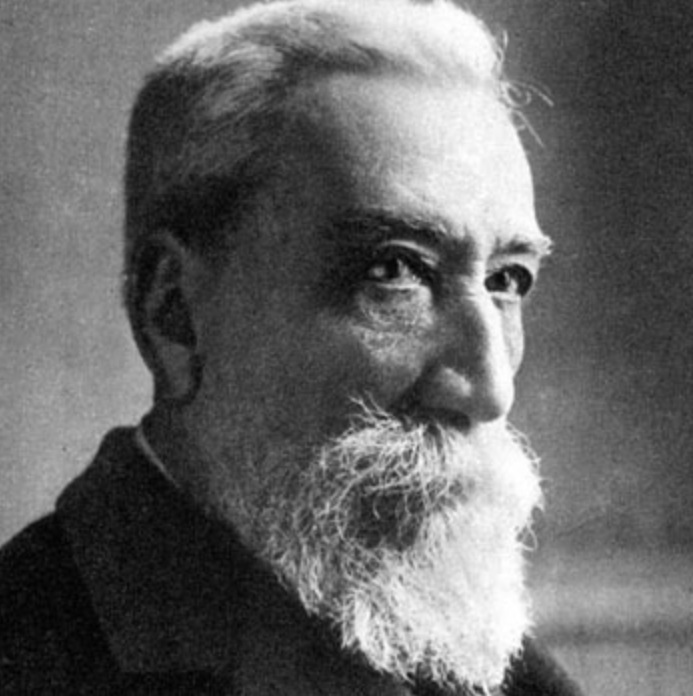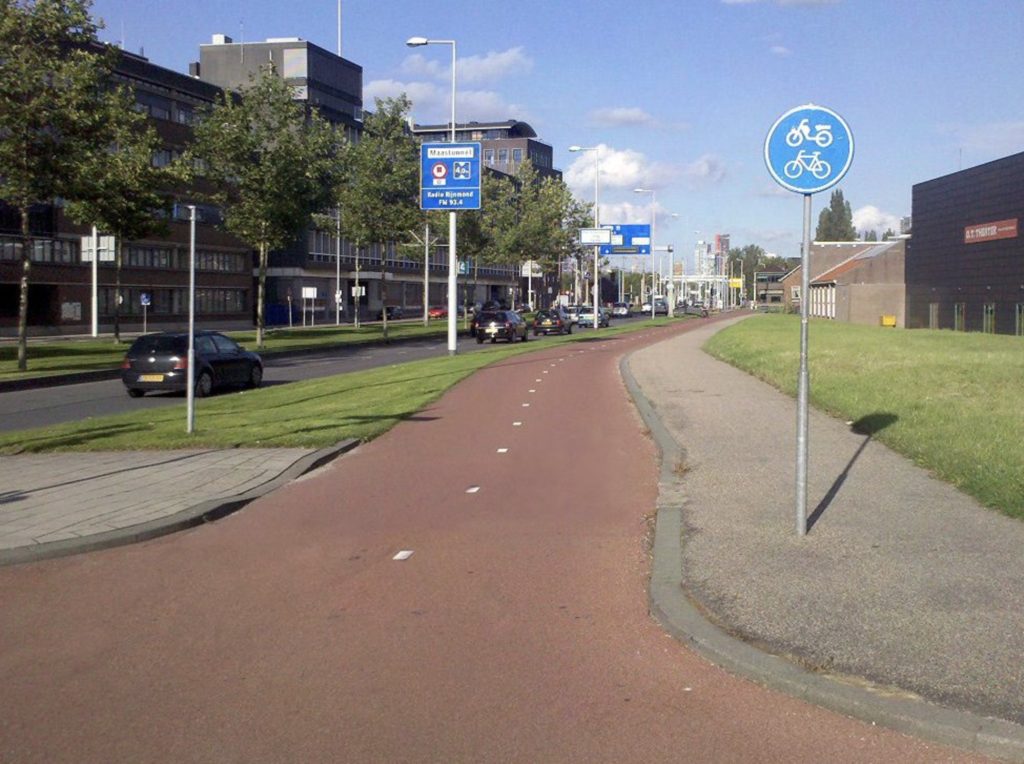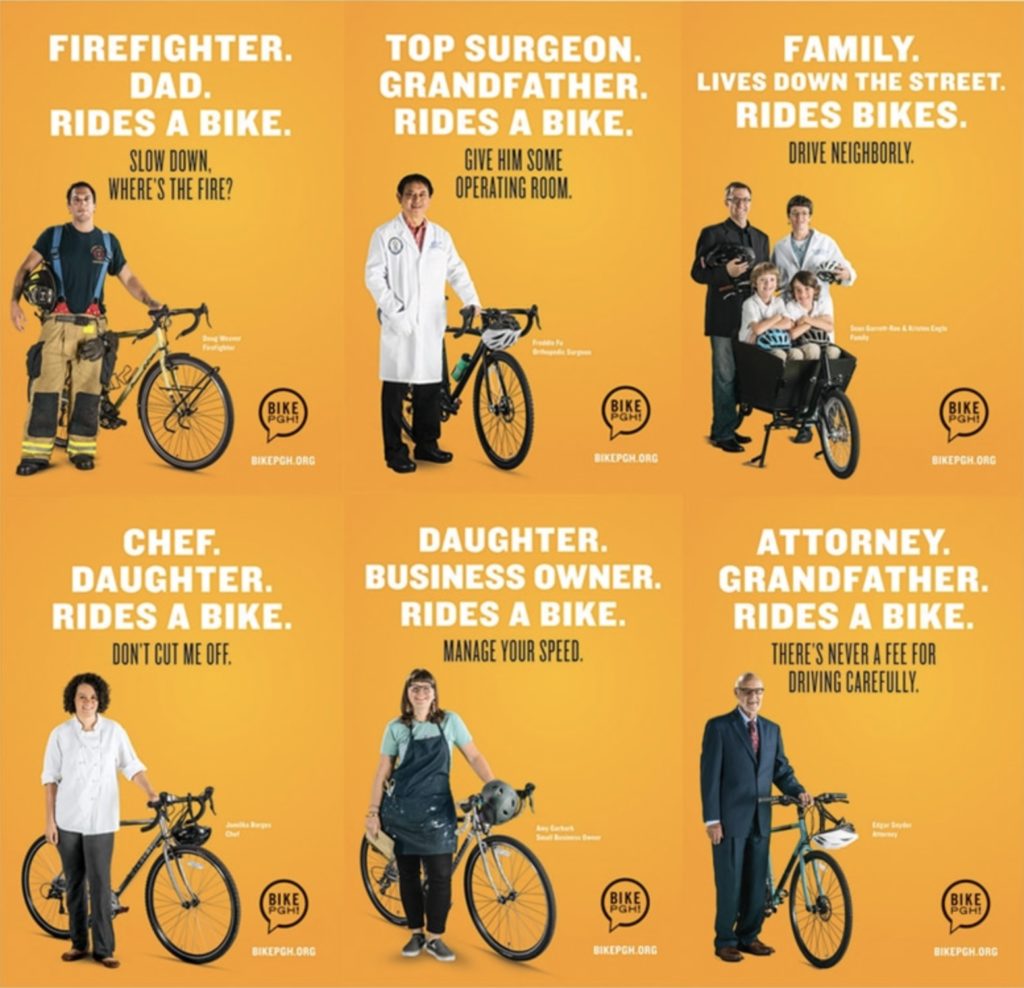Cyclists are dying in record numbers in traffic, and it’s only getting worse.
And we know why. Inattentive and distracted driving, careless and reckless driving, and deliberate aggression against cyclists are all taking their toll. Something needs to be done, but mandatory bicycle helmet laws are not the answer, because they do nothing to address the real problems cyclists are facing. Bicycle helmets won’t change driver behavior for the better.
In fact, we know that bicycle helmets actually change driver behavior for the worst.
But we also know exactly what does keep cyclists safe. And we don’t even have to reinvent the wheel to do it. In countries where cyclist safety is actually prioritized, we see large numbers of people riding bikes, and almost none of them wear helmets. The reason we see large numbers of people riding bikes in these countries is simple—their safety is prioritized, and it shows in both the cycling infrastructure, and in the underlying laws that protect cyclists and penalize careless driving.
And because cyclist safety is prioritized, everybody “from 8 to 80” feels safe when they ride—so safe that they don’t need helmets, or reflective and hi-viz clothing, or video cameras to record what drivers did to them, or special classes to ride. They get on a bike, and they ride, and they get there safely. They don’t even think of themselves as “cyclists.” They’re just people riding a bike.

There’s no need to reinvent this wheel. What works has already been demonstrably proven over several decades of real-world experience. If we’re really serious about bringing the injury and fatality numbers down, here’s how we do it:
Change the Laws
In the United States, we pride ourselves on being a nation of laws, where all are equal under the law. Unfortunately, what sometimes looks on the surface like equality under the law actually protects the most powerful at the expense of the least powerful. Our traffic laws, and how we deal with traffic violence, are prime examples. Some of the problems we encounter:
Unequal Equality
In the 19th century, bicyclists fought in the courts and in the legislatures for their right to the road. Through the combined efforts of cyclists determined to assert their right to ride on the roads, the legal and legislative advocacy backing of the League of American Wheelmen (now the League of American Bicyclists), and the financial backing of Albert Pope (the manufacturer of Columbia Bicycles), courts and legislatures established that cyclists have a right to the road—a right we still have to this day.
This wasn’t just legal altruism on the part of the courts and legislatures. By establishing legal rights for cyclists, the courts and legislatures were also establishing legal duties for cyclists. They were in effect saying that “yes, cyclists do have legal rights, and that also means they have corresponding legal duties.” This meant that the laws apply to cyclists and could be enforced.
Today, this legal principle of corresponding rights and duties is enshrined into our state laws. For example, Oregon’s bicycle laws begin with this declaration: “Every person riding a bicycle upon a public way is subject to the provisions applicable to and has the same rights and duties as the driver of any other vehicle concerning operating on highways…”

“The law, in its majestic equality, forbids rich and poor alike to sleep under bridges, to beg in the streets, and to steal their bread.”
– Anatole France
In principle, this makes a lot of sense. But in practice, it doesn’t always make sense. Consider what happens when two drivers have a fender bender. With seat belts, air bags, and crumple zones, drivers’ bodies are wrapped in a protective cocoon. In a minor low-speed collision—a “fender bender”—the drivers may be fortunate and walk away with only some minor aches and pains.
But what would only be a “fender bender” between two automobiles isn’t as minor in a car-on-bike collision. There, the cyclist is virtually certain to be injured, while driver is virtually certain to be uninjured.
And yet the law treats both collisions exactly alike. In the fender bender, the insurance companies of the two drivers will negotiate over who was negligent, and who pays what. But in the car-on-bike collision, the injured cyclist must prove that the driver was negligent, while the driver’s insurance company will often deny that their driver was negligent, and claim that it was the cyclist who was negligent. The injured cyclist is at a disadvantage both physically in the collision, and in the legal wrangling in the aftermath of the collision.
In the Netherlands, this disadvantage has been flipped to protect the cyclist. Dutch law presumes that in a car-on-bike crash, the driver is negligent, but the driver can rebut this presumption of negligence with proof that the cyclist was negligent. This puts the burden of proof where it belongs—on the person who caused the injury—and it also puts the greater burden of safety on the person who has the greatest capacity to cause harm.
In contrast, in the United States, we put the greater burden for safety on the person who has the least capacity to cause harm, and the most to lose in a collision. When compounded with weak laws, lax enforcement, minimal driver training, and licenses that are easy to obtain and hard to lose, there is little incentive for motorists to drive safely.
Donut Holes
In the United States, a driver can kill a cyclist and receive no more consequence than a traffic citation for a minor traffic violation. This is because, understandably, we don’t want to send people to prison for what amounts to making a mistake. So, as a consequence, we have traffic citations for people who made a mistake, and prison for people whose negligent behavior or intentional behavior was so extreme that it was actually criminal behavior.
The problem is, there’s no middle ground between those two extremes. A driver can make an unsafe lane change and get a ticket. A driver can make an unsafe lane change and unintentionally kill somebody as a result of that traffic violation, and receive the exact same ticket. In lieu of actual consequences for unsafe driving that kills somebody, we’re offered bromides about the driver’s “feelings.”
And that’s insulting to the victims of careless drivers.
We don’t have to limit ourselves to these two extremes and eyeroll-inducing bromides about the driver’s “feelings.” A middle ground between a traffic citation and prison time is possible, where a driver who injures somebody faces greater consequences than a driver who violates the law but doesn’t injure somebody, and where a driver who kills faces even greater consequences, while still reserving prison time for serious criminal offenses like killing somebody while DUI.
By putting minor traffic violations that result in injury or death in this middle ground, we send a message to drivers that they are expected to be careful when driving, and will face more substantial consequences if they are not careful and injure or kill somebody as a result of their carelessness.
Make Bicycle-Friendly Laws
If we want to protect cyclists by making bicycling safe for “everybody from 8 to 80,” we need to make our laws more bicycle-friendly so people who want to ride will feel encouraged and supported, rather than discouraged and unsupported.
One example: In Oregon, there has been a long battle to change state law to allow cyclists to treat stop signs as if they are yield signs. Cyclists rolling stop signs is a red flag for a lot of motorists and legislators, who see it as blatant disregard for the law. But cyclists tend to see rolling stop signs as a sensible method of safely getting through an intersection, because they recognize through personal experience that a bicycle is not exactly like a car, and therefore, will sometimes have different needs than a car. Unlike a car, which is operated via a gas pedal, a bicycle is operated via the rider’s muscles, and thus, when entering an intersection, a bicycle is at its least stable if it’s coming from a dead stop.
The obvious solution is to treat bicycles as a different type of vehicle, with different characteristics and different needs, and therefore, sometimes subject to different laws. Not “lawlessness,” just “different laws.” The laws already do this in recognition that bicycles are not as fast as cars, so it’s not as if legal principles are being upended if we make the laws a better fit for cyclists.
When it makes sense to require bicycles to stop at intersections—typically, at red lights—we have another opportunity to recognize the inherent differences between bicycles and motor vehicles, simply by adjusting the timing of the lights so that bicycles have priority entering the intersections. And what about that wait before entering the intersection? In Portland, the city installed Bike Boxes that gave cyclists priority positioning ahead of motor vehicles. These are actually infrastructure changes, but they illustrate how infrastructure and laws can work together to encourage and support bicyclists.
Another example: In Oregon, cyclists and motorists are subject to exactly the same penalties for DUI. To some, this may seem fair on its surface, in the name of equal rights and responsibilities under the law. But it actually makes no sense at all. DUI is a serious offense because driving under the influence is one of the greatest causes of injuries and fatalities on our roads. But walking while under the influence is at best a minor offense, because drunken pedestrians are mostly a danger to themselves. However, in Oregon, cyclists who are over the limit are treated exactly the same as they would be if they were behind the wheel of a motor vehicle. A conviction for a first offense on a bicycle will result in a criminal record and a mandatory one-year suspension of your driver’s license.
In California, on the other hand, bicycling under the influence is still a violation, but is not as serious an offense as DUI. This is a more sensible approach to the law, one that recognizes that there is a world of difference between intoxicated drivers, who can cause horrendous damage to others, and intoxicated bicyclists, who are mostly a harm to themselves.
Change Law Enforcement
It’s one thing to enact laws that support and protect our most vulnerable road users. It’s another thing to enforce those laws. Time and time again, we’ve seen a strong law enforcement bias against cyclists. Law enforcement will no doubt object strenuously to that truth, but observation bears it out. In New York City, we have seen relentless enforcement blitzes against cyclists when cyclists are killed, but no corresponding enforcement blitzes against careless drivers. The usual suspects: Cyclists who leave the bike lane because a police car is parked there; cyclists who are breaking an imaginary law; kids riding bikes without bells; cyclists who are having a holiday barbeque.
That will teach cyclists for dying.
We have seen good laws go unenforced. We have seen police blame cyclists for their own deaths at the hands of negligent drivers. We have seen police refuse to investigate fatal collisions. We have seen police announce that no charges would be filed, before the investigation was complete. We have seen District Attorneys refuse to prosecute clearly negligent drivers. Time and time again we have seen police bend over backwards to excuse careless drivers. Time and time again, we have seen law enforcement officers who don’t know and don’t understand the laws they are tasked with enforcing.
The best laws are worthless in the hands of the worst police.
If we want to save lives, we need to pass good laws, and we need good law enforcement officers, from the top down, and good training for those officers.
Change the Infrastructure
In the United States, cyclists are given infrastructure guaranteed to get cyclists killed and keep riding numbers low: Cyclists are told to ride in traffic with fast-moving multi-ton motor vehicles that are operated by inadequately educated and trained drivers who deliberately distract their attention away from the road; who feel no obligation to pay attention to their driving; who treat speed limits and other traffic laws as mere suggestions; who refuse to understand that they do not have exclusive access to the road; who mistakenly believe that they have a “right” to the road and that cyclists are breaking the law by riding on the road; and who are often quickly roused to anger and violence when they encounter cyclists riding on “their” road.
All of this is compounded by the requirement for cyclists to ride to the right, often in “bike lanes” which are indicated by a line of white paint “separating” them from traffic, placing them at risk of getting right-hooked at every driveway and intersection.
To mitigate these appalling conditions, cyclists are urged to wear bright colors, record their rides with video, and take special classes so they can learn how to ride in traffic. And of course, the cure-all: cyclists are told to wear helmets.
On the other hand, the reason we see large numbers of people on bikes in countries like the Netherlands and Denmark is because their safety is taken seriously by those countries. And the most visible aspect of that prioritization of cyclist safety is the infrastructure dedicated to cyclists. In these countries, “separated bike lanes” doesn’t mean painting a line on the road to keep the cyclist in the gutter. The separation is physical. When people have their own space to ride, with true separation from motor vehicles, more people feel safe, and so more people ride.

And this is the thing that these countries have figured out: A large number of people actually want to ride bikes. But what most people don’t want is to feel like they’re risking their lives every time they get on a bike. In the United States, a very small number of “strong and fearless” cyclists feel comfortable riding mixed in traffic with motor vehicles. In Portland, Oregon, the “strong and fearless” subset of cyclists was estimated to be 0.5% of Portland’s population at the height of Portland’s 2000’s bike craze—a time when Portland was said to be America’s “bicycling capital,” and the envy of cycling advocates across the nation with its whopping 6.5 % share of residents who commute by bike.
In contrast, there is a much larger demographic of people in Portland, representing some 60% of Portland’s population, who are interested in riding a bike, but are also concerned about their safety. This “interested but concerned” demographic shows a strong preference for protected infrastructure. What this means is that if we build infrastructure that prioritizes bicyclist safety, and make bicycling safe for “everybody from 8 to 80,” most people will ride a bike. Not necessarily every day, and everywhere, but most people are interested in riding, and will ride if their safety is prioritized.
The Culture Changes
The 6.5% of Portlanders who ride a bike seems massive compared to other American cities. But it’s just a small fraction of the share of bicycle commuters in countries that take bicyclist safety seriously. In America, that last sentence will bring a rash of “cyclists break the law” comments, which are apparently the reason we should do as much as possible to harm people on bikes. Never mind the fact that drivers break more laws more often, facts and logic are of little consequence when there are axes to grind.
But maybe American bicyclists are just particularly prone to scofflaw behavior. Maybe it’s completely different in the Netherlands, with Dutch cyclists riding in neat, orderly formations, scrupulously observing all laws. Maybe that’s why bicyclists there are treated as if they’re human beings or something.
Nope. Dutch cyclists break the law too.
Cyclists Behaving Badly—Understanding Cyclist Disobedience
So what gives? Dutch bicyclists break the law, and their lives are still valued? Even when some people wish the laws were enforced more often?
Here’s why:
In America, people who ride bikes are “cyclists.” People who drive cars are “drivers.” People who ride buses and trains are “transit commuters.” And people who walk are “pedestrians.”
In the Netherlands and other cycling friendly countries, people who ride bikes are “people.” People who drive cars are “people.” People who ride buses and trains are “people.” And people who walk are “people.”
Not only that, but all of these “people” are people you know. Your classmates. Your colleagues. Your neighbors. Your friends. Your family members.
And of course, they’re also you.
In a culture where your classmates, colleagues, neighbors, friends and family members—and maybe even you—are all getting around by bike, it doesn’t make any sense for someone to say that “cyclists aren’t deserving of any protection because this one time, I saw somebody on a bike break a law.”
After all, that somebody might be your son, or daughter, or grandmother.

Here, in America, we have to have remind people that bicyclists are actually human beings, and even then, they’ll dig their heels in and say you deserve to die, “because this one time, I saw somebody on a bike break the law.”
OK, I’m exaggerating. They’ll probably say “All cyclists break the law all the time.” But really, what they probably saw was closer to “this one time, I saw somebody on a bike break the law.”
And good luck countering that with actual facts about drivers who break the law. In their minds, cyclists deserve fire and brimstone, while drivers are just people using the roads they built and paid for.
In other words, they don’t know anybody who rides a bike, because we live in a culture that doesn’t prioritize bicyclist safety, and therefore, because riding a bike doesn’t feel safe for “everyone from 8 to 80,” many people who would ride if they felt safe don’t ride because they don’t feel safe. And because many people don’t feel safe riding a bike, the haters don’t know anybody who rides.
It’s a vicious cycle.
And the solution is simple: Ignore the haters, make cycling safe for everyone from 8 to 80, and more people will ride. When more people ride, it becomes “normal,” and soon that hater has friends, neighbors, and even family members who ride a bike. Now does that hater still think that cyclists deserve to die?
The Bottom Line
Cyclists are dying in record numbers, and we know why. We also know how to turn that around. We already know what works.
And we also know what doesn’t work. We know that mandatory helmet laws are not the answer. They are what the people who are tasked with our safety propose when they don’t really want to do what needs to be done to save lives, but know they need to look like they are doing something. So they turn to the easy way out. They turn to mandatory helmet laws, because mandatory helmet laws look like something is being done, when in fact, the status quo is continuing and nothing is being done.
Changing the laws. Changing law enforcement. Changing the infrastructure. Changing the culture.
That is where our safety and our future lies.




